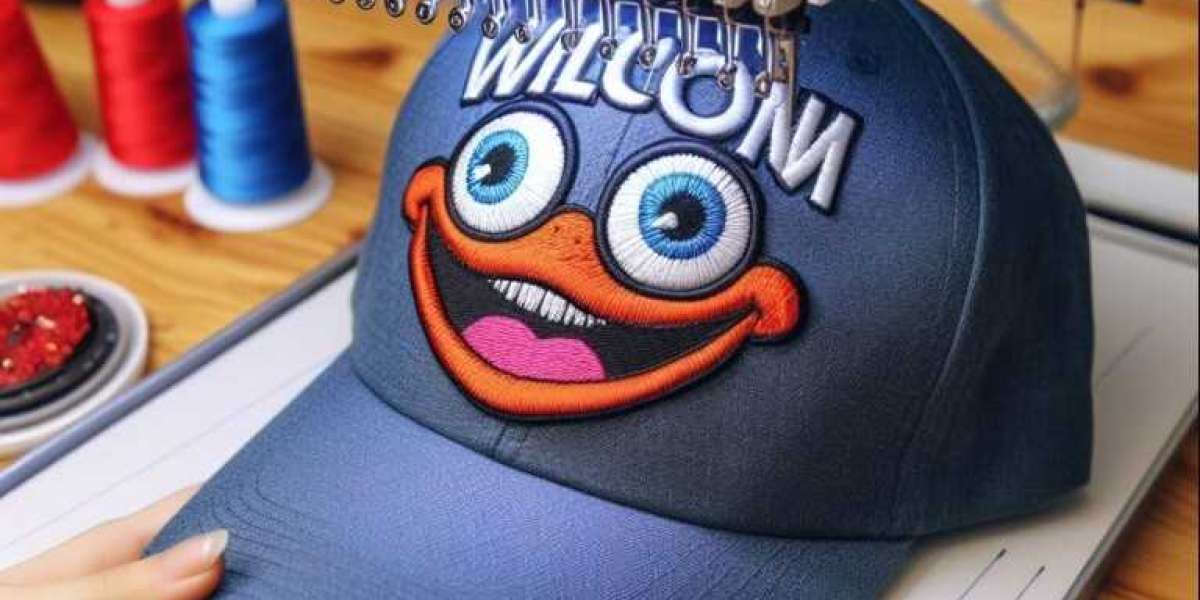So, you're interested in embroidery on hats? Whether you're starting a custom cap business, branding uniforms, or just want to personalize your own snapbacks, embroidery digitizing on hat is the first step to stitching success.
But here's the catch: hats aren’t flat like t-shirts or towels. They're curved, structured, and often made from tricky materials. That’s where digitizing — the process of turning an image or logo into a machine-readable stitch file — becomes crucial.
In this beginner-friendly guide, we’ll walk you through everything you need to know about digitizing embroidery for hats, from design prep to file formats, stitch techniques, and common mistakes to avoid.
What Is Embroidery Digitizing for Hats?
Embroidery digitizing for hats is the art (and science) of converting a design or logo into a special embroidery file (like DST or PES) optimized for curved surfaces.
Unlike flat fabric, a hat's shape, seam placement, and structure require a more tailored approach to stitch direction, density, and design positioning.
Done right, digitizing for hats ensures your embroidery:
- Stitches smoothly without gaps or distortion
- Centers properly on the hat's front panel
- Handles seams, curves, and buckram stiffness
- Looks professional and clean
Why Hat Digitizing Is Different from Flat Embroidery
Most embroidery beginners make the mistake of using flat embroidery files on hats. While they may work sometimes, they often cause crooked logos, distorted outlines, and broken threads.
Hats are built different. Here's why digitizing for hats requires special care:
- Curved Surface: The front of a cap curves vertically and horizontally, which can skew flat stitch patterns.
- Center Seam: Many structured hats have a seam down the middle that can disrupt stitches.
- Thick/Stiff Material: Hats are made from canvas, wool, or buckram, which need strong underlay and careful stitch planning.
- Limited Space: Front embroidery areas are usually around 2.25" to 2.5" in height, so designs need to be compact and readable.
Step 1: Choosing the Right Design for Hat Embroidery
Not all designs translate well to caps. Since the embroidery area is small and curved, stick to simple, bold graphics with limited colors and clean lines.
Tips for hat-friendly designs:
- Keep it simple: Avoid tiny details or small text.
- Bold fonts: Choose fonts that are thick and readable.
- Limit colors: 1–3 colors is ideal for hats.
- Solid fills over outlines: Outlined text may get distorted — fill stitches work better on hats.
If you’re working with a complex logo, consider simplifying or adapting it specifically for embroidery.
Step 2: Digitizing Your Design for a Hat
This is where the magic happens. Digitizing software or professional services (like Digitizing Buddy) convert your image into an embroidery file that’s optimized for hat embroidery.
Key digitizing considerations for hats:
1. Stitch Order (Bottom to Top, Center Out)
The design should start in the center and work outward, minimizing distortion. Start with underlay, then main fills, then final details.
2. Underlay Stitches
Thicker materials like caps need strong underlay for clean results — typically edge run + zig-zag combo.
3. Density Settings
Keep stitch density slightly lighter than on flat garments to avoid stiffness or thread breaks.
4. Short Stitch Length
This helps the stitches curve with the hat and hug seams better.
5. Push and Pull Compensation
Account for the fabric's natural shifting to maintain alignment. This is especially important on structured hats.
6. Avoid Jump Stitches
Too many trims or jumps may cause thread breaks on stiffer materials.
Best File Formats for Hat Embroidery Machines
Your digitized file must be compatible with your machine. Common formats include:
File Format | Used By |
DST | Tajima, Ricoma, Brother (pro) |
PES | Brother, Babylock, Bernina |
EXP | Melco, Bernina |
JEF | Janome |
XXX | Singer |
Ask your digitizer or use a converter to ensure your file matches your machine’s needs.
Choosing the Right Hat for Embroidery
Not all hats are embroidery-friendly. Before digitizing, decide what hat type you're working with:
1. Structured Caps
These have firm fronts (buckram). Great for clean logos. Requires strong digitizing.
2. Unstructured Caps
Soft and flexible. Good for a more relaxed look. Easier to embroider but needs backing.
3. Trucker Hats
Mesh backs — only the front is embroiderable. Often structured.
4. Beanies
Flat surface but stretchy. Needs light density and stretch-friendly digitizing.
Tip: Always stabilize your hat correctly in the hoop or cap frame to avoid shifting.
Hoop or Frame: Securing Your Hat
Most embroidery machines require a cap frame or hat hoop attachment for embroidering on curved surfaces.
Tips for hooping hats:
- Pull the sweatband back before hooping
- Make sure the hat is taut and centered
- Use a tear-away stabilizer behind the embroidery area
- Mark the center point to align the design perfectly
Common Hat Digitizing Mistakes (And How to Avoid Them)
Even seasoned embroiderers mess up hat designs without the right digitizing. Avoid these rookie mistakes:
Mistake | How to Avoid |
Using flat embroidery files | Always digitize specifically for hats |
Tiny details or fonts | Simplify your design and use bold, thick fonts |
Ignoring center-out rule | Always start stitching from center outward |
Skipping underlay | Use edge run and zig-zag for better support |
Wrong stabilizer | Use tear-away for structured hats, add topping if needed |
Poor hooping | Invest time in proper cap framing to avoid misalignment |
Best Practices for Clean Hat Embroidery
- Use high-quality polyester threads for durability
- Keep machine tension consistent
- Run a test stitch on a scrap hat before final production
- Don’t crowd the design — less is more on hats
- Monitor stitch-out closely, especially near seams
Want to Save Time? Use a Professional Digitizer
Learning to digitize hats takes time and experience. If you're new to embroidery or don’t want to risk ruining blank caps, let a pro handle it.
We recommend Digitizing Buddy, known for their fast, accurate, and affordable digitizing services for hats, jackets, polos, and more. Their team understands the nuances of cap embroidery and ensures your file is optimized for clean, perfect stitching — no matter what machine you use.
Final Thoughts: Embroider with Confidence
Embroidery digitizing on hats might seem tricky at first, but once you understand the rules — and use the right tools — you’ll get pro-quality results every time.
Remember: digitizing is the blueprint for your stitches, and hats are a different ball game than flat surfaces. Take your time, test your design, and if you’re in doubt, let a professional digitizing service like Digitizing Buddy turn your logo into a hat-ready masterpiece.








